HP Folio 13 Review: Deviating From the Norm
by Dustin Sklavos on April 17, 2012 12:30 AM EST- Posted in
- Laptops
- Intel
- HP
- Sandy Bridge
- Ultrabook
System Performance
By opting to employ an Intel Core i5 instead of Core i7 (ULV, of course), and then only operating the DDR3 in single-channel mode, HP puts the Folio 13 at a bit of a disadvantage compared to the competition. The Toshiba Portege Z830 is the only one that really has things worse off, but it's also the least expensive of the lot. Here's how the performance charts pan out:
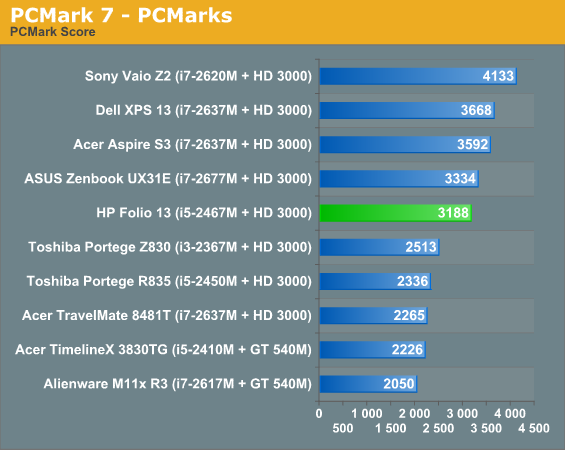
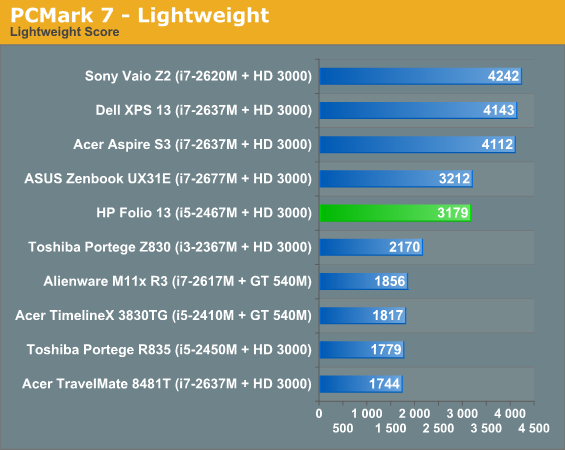
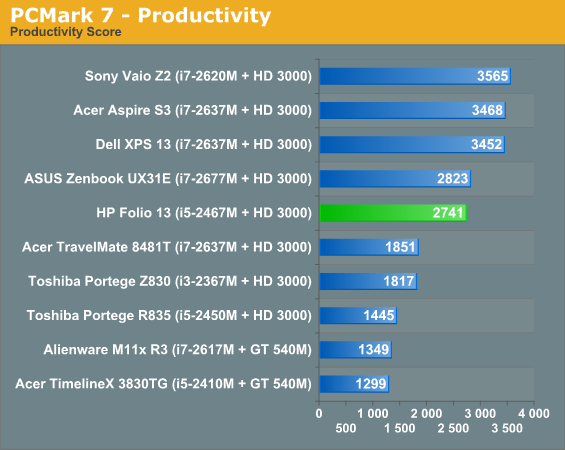
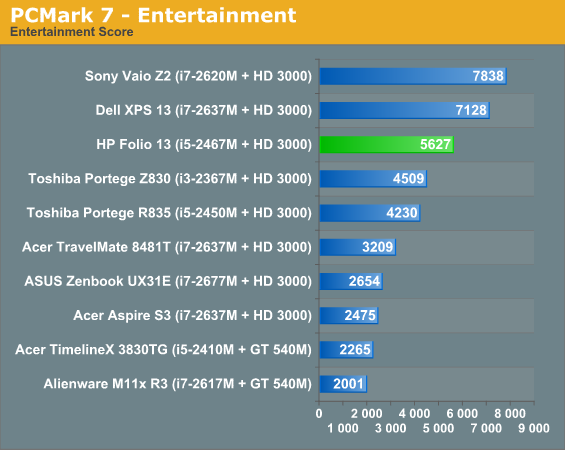
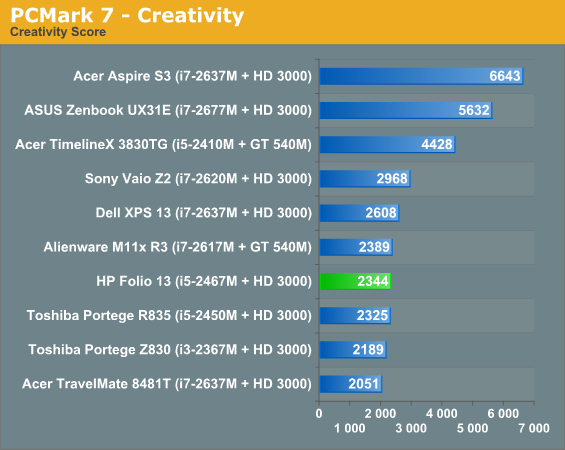

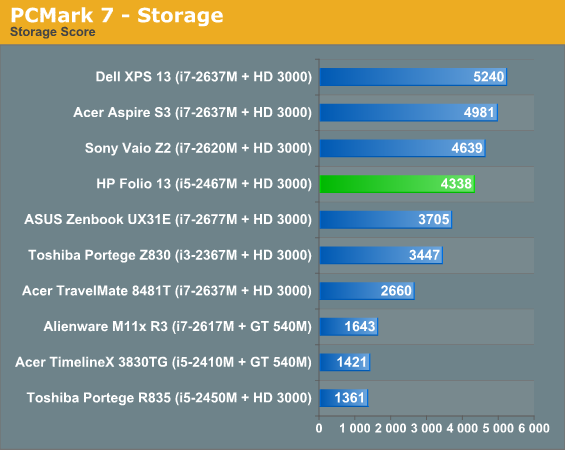

Ultimately the Folio 13 bounces around the middle of our PCMark charts, buoyed somewhat by the decent Samsung SSD included. You can certainly make the case that all of the above systems are "fast enough" for most users, and the SSDs in the ultrabooks definitely help in that regard. As long as you're not doing any heavy number crunching or trying to play games, ULV Sandy Bridge is likely more than sufficient.

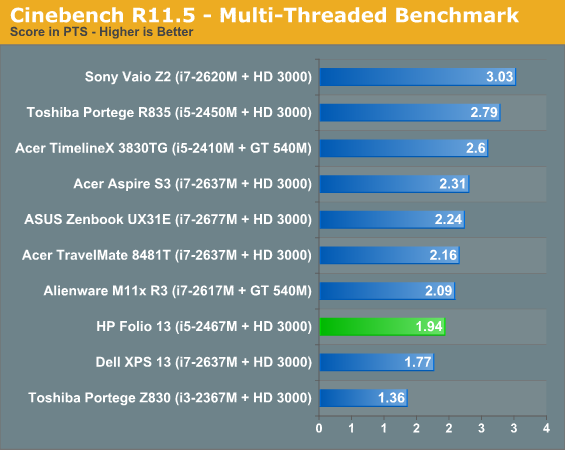
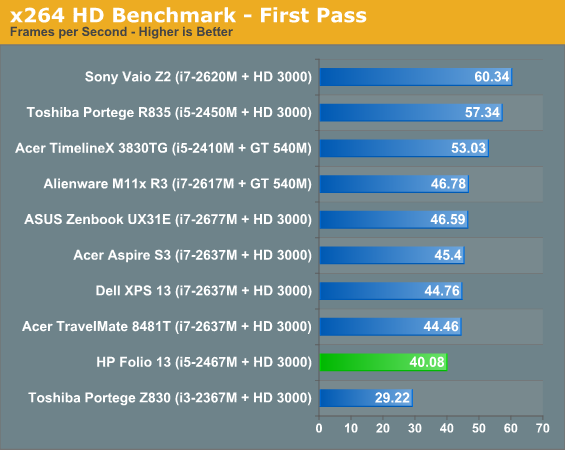
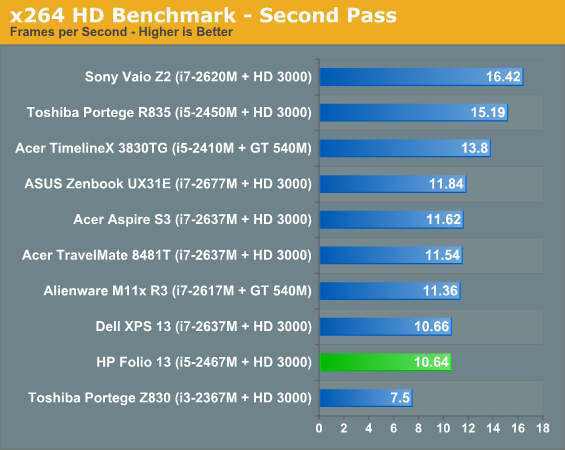
Unfortunately, once we get to the CPU-isolated tests, the Folio 13's i5 gets absolutely buried, only really able to best the Toshiba Portege Z830's i3. The difference between the two is wide enough to make the i3's lack of turbo boost felt, but the i7 systems almost all put in stronger showings across the board with the exception of the Dell XPS 13, which may be struggling with thermal limitations. If we ignore the full-voltage CPUs, the difference between the i5-2467M and the fastest i7-2677M ranges from as little as 11% in the second pass of our x264 test to as much as 28% in our single-threaded Cinebench result. That's certainly noticeable, but it may not be worth the added cost--HP obviously felt the i5-2467M was a good balancing point, since they didn't bother to support any of the other ULV chips.
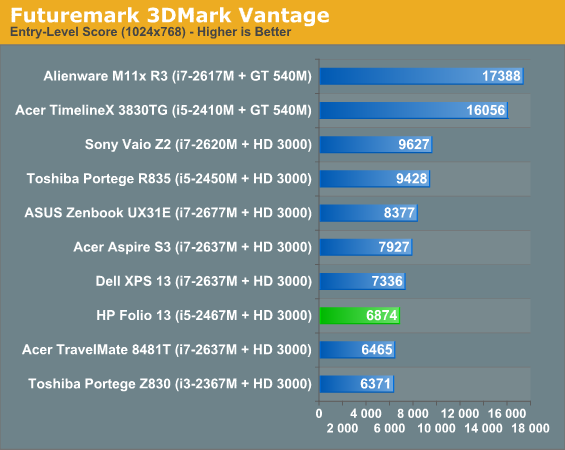
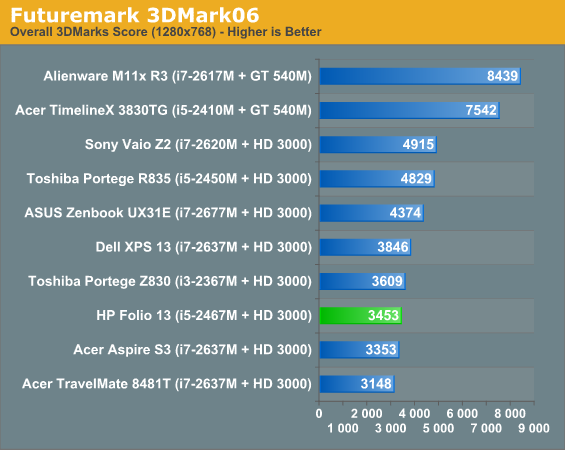
3DMark once again reminds us that these aren't gaming machines; the thin-and-lights equipped with dedicated graphics fare worlds better. Llano likewise easily surpasses the ULV HD 3000, and in fact outside of single-threaded performance the quad-core Llano chips generally offer comparable to superior performance; of course, getting Llano into an ultrabook form factor with an SSD would require some changes to the design and pricing strategry for such laptops.










88 Comments
View All Comments
piroroadkill - Tuesday, April 17, 2012 - link
So it has a low end CPU, only one memory slot, a 1366x768 screen, HPs bloody AWFUL touchpad, Intel 3000 graphics.That sounds like par for the course for HP. Although the one memory slot thing is especially odd. Nothing else is significant. I would never buy an HP laptop with their all-in-one touchpad.
It's so bad that even if somehow the rest of the laptop was great (it isn't) I wouldn't consider it.
ShieTar - Tuesday, April 17, 2012 - link
You write"HP's engineers took a look at Intel's ultrabook spec and, rather than see how small they could get their design, opted to see just how much they could pack into the spec."
and then
"HP has strangely opted to be much more conservative with speccing their ultrabook than other vendors have"
and also
"Ultimately, though, the Folio 13 is rather tame for an ultrabook, all the more perplexing since other vendors were able to cram more power into smaller designs."
It seems to me like your first line is not based in reality, but that they rather opted to see just how much profit margin the can get away with.
Dustin Sklavos - Tuesday, April 17, 2012 - link
Look at the size of the integrated battery, ports available, and the quality of the keyboard compared to other ultrabooks.ImSpartacus - Tuesday, April 17, 2012 - link
Yeah, this machine really is a puzzling design choice.I've long lusted for the "RAZR Maxx" of Ultrabooks. Take a thin machine and fill it up with battery until it is about the thickness of a "non-thin" machine.
But HP managed to tank efficiency enough that it doesn't matter. Quite disappointing.
rkhpedersen - Wednesday, April 18, 2012 - link
Why do you keep mentioning the battery? According to yourself it does not deliver.JNo - Tuesday, April 17, 2012 - link
I concur, there's a lot of contradictory (and therefore confusing) statements in this review Dustin. Your main positives seem to be the keyboard and a 'boxy' design that isn't leveraged for other benefits. You then say it's your favourite ultrabook to date along with the Dell whilst complaining about all the shortcomings. The reasons for it being favoured seem thin on the ground and at odds with the rest of your tone.JarredWalton - Wednesday, April 18, 2012 - link
The reasons to favor one laptop over another almost always come down to the feel of the system in actual use -- and I'm not talking about speed and performance. I too think the boxier design with deeper key presses is a good thing -- the ultra-thin wedges on other ultrabooks leave the typing experience severely compromised. The rest of the stuff HP did is certainly "deviating from the norm", but unfortunately much of it is in a not-so-good way.Single-channel RAM probably only costs 5-10% performance at best (e.g. in graphics tests where IGP and CPU are being pegged), but when a smaller laptop can have two SO-DIMM slots there's no good reason for the change. Locking down the CPU is okay, as the i5 ULV works well enough, but was that necessary? The larger battery on paper should be great, but it fails to deliver (likely from lack of careful power tuning optimizations).
Despite the above, the pricing is still reasonable compared to the competition. I'd love a better display (as always), but the Folio runs cooler and quieter than other ultrabooks and the keyboard is more comfortable to type on, with most other areas being more or less "equal". So yes, that makes it a "favorite", but as noted in the conclusion it's still flawed.
french toast - Tuesday, April 17, 2012 - link
Can i make a request? I have noticed from other sites that both batterylife AND performance fluctuates wildely when notebooks/ultrabooks are run off battery instead of mains....From what i can tell most of your tests come from the mains to test absolute best case scenario performance..where as in most cases that form factor is going to be used on the move, so the most relevant benchmark/gaming scores are going to come off battery power, not mains.
I have noticed that Intel 17w chips perform SIGNIFICANTLY worse when running off battery compared to Mains...likely AMD also, would it then be possible to include in the same graphs the benchmarks/gaming score from running off the deviced battery so readers can see the REAL performance whilst out and about...i just don't think the performance measurements are representative for the scenario it would be used.
I enjoy your reviews by the way ;) Thanks.
jamawass - Tuesday, April 17, 2012 - link
Jarred Walton recently tested an AMD based notebook which showed gaming performance does not deteriorate on battery power compared to intel.french toast - Wednesday, April 18, 2012 - link
The point im getting at, and somewhat backed up by what you have said, is that intel iGP is terrible when running off a battery in comparison to AMD.What people think they are getting and what they actually get in real world are not the same things, you don't but a laptop to have it plugged into the mains, they are designed to be carried around..i just think it would be more approapriate to test with and with out battery in the same chart...its more accurate...other websites do it.
http://techreport.com/articles.x/21902/7
I will wait a while if i don't get noticed down in the comments section i will email in with a request, would be really great if Anandtech could do this IMO.